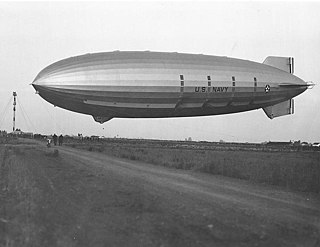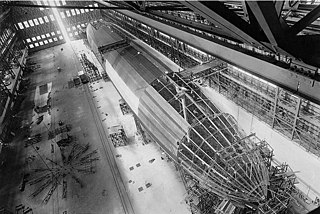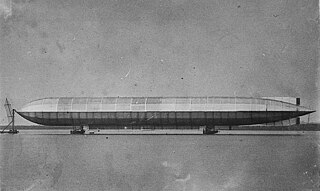
A blimp (/blɪmp/), or non-rigid airship, is an airship (dirigible) without an internal structural framework or a keel. Unlike semi-rigid and rigid airships, blimps rely on the pressure of the lifting gas inside the envelope and the strength of the envelope itself to maintain their shape. Blimps are known for their use in advertising, surveillance, and as observation platforms due to their maneuverability and steady flight capabilities.

An airship or dirigible balloon is a type of aerostat or lighter-than-air aircraft that can navigate through the air under its own power. Aerostats gain their lift from a lifting gas that is less dense than the surrounding air.

USS Akron (ZRS-4) was a helium-filled rigid airship of the U.S. Navy, the lead ship of her class, which operated between September 1931 and April 1933. It was the world's first purpose-built flying aircraft carrier, carrying F9C Sparrowhawk fighter planes, which could be launched and recovered while it was in flight. With an overall length of 785 ft (239 m), Akron and her sister ship Macon were among the largest flying objects ever built. Although LZ 129 Hindenburg and LZ 130 Graf Zeppelin II were some 18 ft (5.5 m) longer and slightly more voluminous, the two German airships were filled with hydrogen, and so the two US Navy craft still hold the world record for the largest helium-filled airships.

USS Shenandoah was the first of four United States Navy rigid airships. It was constructed during 1922–1923 at Lakehurst Naval Air Station, and first flew in September 1923. It developed the U.S. Navy's experience with rigid airships and made the first crossing of North America by airship. On the 57th flight, Shenandoah was destroyed in a squall line over Ohio in September 1925.

The ZMC-2 was the only successfully operated metal-skinned airship ever built. Constructed at Naval Air Station Grosse Ile by The Aircraft Development Corporation of Detroit, the ZMC-2 was operated by the U.S. Navy at Lakehurst, New Jersey from 1929 until its scrapping in 1941. While at Lakehurst it completed 752 flights, and logged 2265 hours of flight time.

USS Los Angeles was a rigid airship, designated ZR-3, which was built in 1923–1924 by the Zeppelin company in Friedrichshafen, Germany, as war reparations. She was delivered to the United States Navy in October 1924 and after being used mainly for experimental work, particularly in the development of the American parasite fighter program, was decommissioned in 1932.

The Zeppelin NT is a class of helium-filled airships being manufactured since the 1990s by the German company Zeppelin Luftschifftechnik GmbH (ZLT) in Friedrichshafen. The initial model is the N07. The company considers itself the successor of the companies founded by Ferdinand von Zeppelin which constructed and operated the very successful Zeppelin airships in the first third of the 20th century. There are, however, a number of notable differences between the Zeppelin NT and original Zeppelins as well as between the Zeppelin NT and usual non-rigid airships known as blimps. The Zeppelin NT is classified as a semi-rigid airship.
The AEREON 26 was an experimental aircraft developed to investigate lifting body design with a view to using its shape to create hybrid designs, part airship, part conventional aircraft. It was powered by a piston engine, driving a pusher propeller, and generated lift through the aerodynamics of its lozenge-shaped fuselage.

A hybrid airship is a powered aircraft that obtains some of its lift as a lighter-than-air (LTA) airship and some from aerodynamic lift as a heavier-than-air aerodyne.

A rigid airship is a type of airship in which the envelope is supported by an internal framework rather than by being kept in shape by the pressure of the lifting gas within the envelope, as in blimps and semi-rigid airships. Rigid airships are often commonly called Zeppelins, though this technically refers only to airships built by the Luftschiffbau Zeppelin company.

A thermal airship is an airship that generates buoyancy by heating air in a large chamber or envelope. The lower density of interior hot air compared to cool ambient air causes an upward force on the envelope. This is very similar to a hot air balloon, with the notable exception that an airship has a powered means of propulsion, whilst a hot air balloon relies on winds for navigation. An airship that uses steam would also qualify as a thermal airship.

Solomon Andrews was a doctor, aviator and dirigible airship inventor. Andrews invented an airship called Aereon which received some notice in the 1860s. He claimed to sail it as one would a sailboat. Mention is made of the movement of pilot and passenger fore and aft in the basket to control attitude. He was a medical doctor and three times Mayor of Perth Amboy, New Jersey. He served as the health officer of Perth Amboy, New Jersey and supervised the construction of the city's first sewer system. He served as the Collector of the Port of New Jersey in Perth Amboy from 1844 to 1845.

The Supermarine Seamew was a British twin engined amphibious aircraft built by Supermarine at their works in Woolston, Southampton. It was intended as a small, shipborne reconnaissance aircraft. It was designed in 1925–1927 by R. J. Mitchell to meet the Air Ministry's specification 29/24. It was the first aeroplane built by Supermarine to incorporate metal in the construction; two machines were built. Mitchell planned a civilian version of the aircraft, to accommodate up to six passengers.
Aeros Corp is an American manufacturer of airships based in Los Angeles, California. It was founded in 1993 by the current CEO and Chief Engineer, Igor Pasternak, who was born in Soviet Kazakhstan, raised in Soviet Ukraine, and moved to the U.S. after the Soviet collapse to build airships there. It currently employs more than 100 workers.

The two Hindenburg-class airships were hydrogen-filled, passenger-carrying rigid airships built in Germany in the 1930s and named in honor of Paul von Hindenburg. They were the last such aircraft to be constructed, and in terms of their length, height, and volume, the largest aircraft ever built. During the 1930s, airships like the Hindenburg class were widely considered the future of air travel, and the lead ship of the class, LZ 129 Hindenburg, established a regular transatlantic service. The airship's destruction in a highly publicized accident was the end of these expectations. The second ship, LZ 130 Graf Zeppelin, was never operated on a regular passenger service, and was scrapped in 1940 along with its namesake predecessor, the LZ 127 Graf Zeppelin, by order of Hermann Göring.

His Majesty's Airship No. 1 was designed and built by Vickers, Sons and Maxim at their works in Barrow-in-Furness, Lancashire, England, as an aerial scout airship for the Royal Navy. It was the first British rigid airship to be built, and was constructed in a direct attempt to compete with the German airship programme. Often referred to as "Mayfly", a nickname given to it by the lower deck, in public records it is designated 'HMA Hermione' because the naval contingent at Barrow were attached to HMS Hermione, a cruiser moored locally preparing to act as its tender.

The British R.23X class of rigid airships were developed during World War I using the experience gained from the 23 class, but only two of the planned four R.23X class were built: R.27 and R.29. Both were completed mid-1918, but just 2+1⁄2 months after entering service R.27 was destroyed by fire in a hangar; while R.29 went on to become the most successful British wartime rigid airship, being the only one to meet enemy action, as well as the only one to sink a submarine.

The AeroLift CycloCrane was a unique US hybrid airship which adopted helicopter derived airfoil control for low speed flight manoeuvring by spinning on its axis. It was intended to be a heavy load lifter, initially aimed at the Canadian logging industry. A proof of concept vehicle flew at times during the 1980s, but no large production aircraft were built.
The Aereon Dynairship is a conceptual large hybrid airship developed by the Aereon Corporation for civilian and military cargo transport.

The Akron-class airships were a class of two rigid airships constructed for the US Navy in the early 1930s. Designed as scouting and reconnaissance platforms, the intention for their use was to act as "eyes for the fleet", extending the range at which the US Navy's Scouting Force could operate to beyond the horizon. This capability was extended further through the use of the airships as airborne aircraft carriers, with each capable of carrying a small squadron of airplanes that could be used both to increase the airship's scouting range, and to provide self-defense for the airship against other airborne threats.















